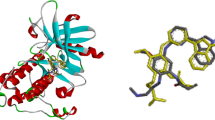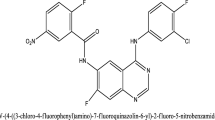Abstract
In modern drug discovery, virtual screening is an attractive and cost-effective approach, which is widely applied to filter chemical compound libraries for the identification of novel inhibitors. Epidermal growth factor receptor protein is a well reported anticancer molecular target due to its over expression and mutation in many solid tumours. The decline in epidermal growth factor receptor activity by small molecules has proved to be an effective treatment for cancer. To design inhibitors for this target, the crystal structures information of epidermal growth factor receptors, co-crystallized with its inhibitors, provide a gateway to perform receptor-based drug designing studies, whereas the inhibitors with their biological activity reported in literature provide information to carry out ligand-based drug designing studies. In the present study, the drug designing methods were strategically combined and used parallely on a library of 50,000 drug-like compounds from ChemDiv and ChemBridge database, for the selection of potential inhibitors of epidermal growth factor receptor. This resulted in the identification of 200 common hits, which were further pruned down to 87, based on the knowledge about the key interaction of known epidermal growth factor receptor inhibitors with Met793. These 87 hits were clustered into 12 different structural moieties. In vitro studies of some of these hits were also carried out in order to validate the screening approach. Further, the lead optimization studies were performed by analyzing the binding poses of all the identified structural moieties in order to ascertain the scope of modifications around these moieties. Molecular dynamics simulation studies further revealed some important residues of the target which may be helpful for providing stability to the enzyme-inhibitor complex. These findings could be very much helpful for a medicinal chemist to design a novel potent inhibitor of epidermal growth factor receptor.










Similar content being viewed by others
References
Aertgeerts K, Skene R, Yano J, Sang BC, Zou H, Snell G, Jennings A, Iwamoto K, Habuka N, Hirokawa A, Ishikawa T, Tanaka T, Miki H, Ohta Y, Sogabe S (2011) Structural analysis of the mechanism of inhibition and allosteric activation of the kinase domain of HER2 protein. J Biol Chem 286(21):18756–18765
Assefa H, Kamath S, Buolamwini JK (2003) 3D-QSAR and docking studies on 4-anilinoquinazoline and 4-anilinoquinoline epidermal growth factor receptor (EGFR) tyrosine kinase inhibitors. J Comput Aided Mol Des 17(8):475–493
Bridges AJ, Zhou H, Cody DR, Rewcastle GW, McMichael A, Showalter HD, Fry DW, Kraker AJ, Denny WA (1996) Tyrosine kinase inhibitors. 8. An unusually steep structure-activity relationship for analogues of 4-(3-bromoanilino)-6,7-dimethoxyquinazoline (PD 153035), a potent inhibitor of the epidermal growth factor receptor. J Med Chem 39(1):267–276
Downward J, Parker P, Waterfield MD (1984) Autophosphorylation sites on the epidermal growth factor receptor. Nature 311(5985):483–485
Engel RH, Kaklamani VG (2007) HER2-positive breast cancer: current and future treatment strategies. Drugs 67(9):1329–13241
Fang Q, Zou C, Zhong P, Lin F, Li W, Wang L, Zhang Y, Zheng C, Wang Y, Li X, Liang G (2016) EGFR mediates hyperlipidemia-induced renal injury via regulating inflammation and oxidative stress: the detrimental role and mechanism of EGFR activation. Oncotarget 7(17):24361–24373
Fidanze SD, Erickson SA, Wang GT, Mantei R, Clark RF, Sorensen BK, Bamaung NY, Kovar P, Johnson EF, Swinger KK, Stewart KD, Zhang Q, Tucker LA, Pappano WN, Wilsbacher JL, Wang J, Sheppard GS, Bell RL, Davidsen SK, Hubbard RD (2010) Imidazo[2,1-b]thiazoles: multitargeted inhibitors of both the insulin-like growth factor receptor and members of the epidermal growth factor family of receptor tyrosine kinases. Bioorg Med Chem Lett 20(8):2452–2455
Ghosh AK, Gemma S (2014) Structure-based design of drugs and other bioactive molecules: Tools and strategies. John Wiley & Sons, Markono Print Media Pte Ltd., Singalpore, pp 1–18
Glide, version 3.6 (2015) Schrodinger. LLC, New York, NY
Instant JChem, version 5.9.4 (2012) ChemAxon (http://www.chemaxon.com)
Jorissen RN, Walker F, Pouliot N, Garrett TP, Ward CW, Burgess AW (2003) Epidermal growth factor receptor: mechanisms of activation and signalling. Exp Cell Res 284(1):31–53
Kawakita Y, Seto M, Ohashi T, Tamura T, Yusa T, Miki H, Iwata H, Kamiguchi H, Tanaka T, Sogabe S, Ohta Y, Ishikawa T (2013) Design and synthesis of novel pyrimido[4,5-b]azepine derivatives as HER2/EGFR dual inhibitors. Bioorg Med Chem 21(8):2250–2261
Kersemaekers AM, Fleuren GJ, Kenter GG, Van den Broek LJ, Uljee SM, Hermans J, Van de Vijver MJ (1999) Oncogene alterations in carcinomas of the uterine cervix: overexpression of the epidermal growth factor receptor is associated with poor prognosis. Clin Cancer Res 5(3):577–586
Kubinyi H (1998) Structure-based design of enzyme inhibitors and receptor ligands. Curr Opin Drug Discov Devel 1(1):4–15
Ligprep, version 3.3 (2015) Schrodinger, LLC, New York, NY.
Lv PC, Li DD, Li QS, Lu X, Xiao ZP, Zhu HL (2011) Synthesis, molecular docking and evaluation of thiazolyl-pyrazoline derivatives as EGFR TK inhibitors and potential anticancer agents. Bioorg Med Chem Lett 21(18):5374–5377
Lv PC, Li HQ, Sun J, Zhou Y, Zhu HL (2010) Synthesis and biological evaluation of pyrazole derivatives containing thiourea skeleton as anticancer agents. Bioorg Med Chem 18(13):4606–4614
Maestro, version 10.1 (2015) Schrodinger. LLC, New York, NY
Maestro-Desmond Interoperability Tools, version 4.1 (2015) Schrodinger. LLC, NY
Pao W, Chmielecki J (2010) Rational, biologically based treatment of EGFR-mutant non-small-cell lung cancer. Nat Rev Cancer 10(11):760–774
Peng YH, Shiao HY, Tu CH, Liu PM, Hsu JT, Amancha PK, Wu JS, Coumar MS, Chen CH, Wang SY, Lin WH, Sun HY, Chao YS, Lyu PC, Hsieh HP, Wu SY (2013) Protein kinase inhibitor design by targeting the Asp-Phe-Gly (DFG) motif: the role of the DFG motif in the design of epidermal growth factor receptor inhibitors. J Med Chem 56(10):3889–3903
Phase, version 4.2 (2015) Schrodinger. LLC, New York, NY
Rewcastle GW, Denny WA, Bridges AJ, Zhou H, Cody DR, McMichael A, Fry DW (1995) Tyrosine kinase inhibitors. 5. Synthesis and structure-activity relationships for 4-[(phenylmethyl)amino]- and 4-(phenylamino)quinazolines as potent adenosine 5’-triphosphate binding site inhibitors of the tyrosine kinase domain of the epidermal growth factor receptor. J Med Chem 38(18):3482–3487
Rewcastle GW, Palmer BD, Bridges AJ, Showalter HD, Sun L, Nelson J, McMichael A, Kraker AJ, Fry DW, Denny WA (1996) Tyrosine kinase inhibitors. 9. Synthesis and evaluation of fused tricyclic quinazoline analogues as ATP site inhibitors of the tyrosine kinase activity of the epidermal growth factor receptor. J Med Chem 39(4):918–928
Rosenthal AS, Tanega C, Shen M, Mott BT, Bougie JM, Nguyen DT, Misteli T, Auld DS, Maloney DJ, Thomas CJ (2010) An inhibitor of the Cdc2-like kinase 4 (Clk4). National Center for Biotechnology Information (US), Bethesda, MD, Probe Reports from the NIH Molecular Libraries Program [Internet]
SciFinder, CAS, Ohio, USA, https://scifinder.cas.org/scifinder, Accessed Feb 2016
Showalter HD, Bridges AJ, Zhou H, Sercel AD, McMichael A, Fry DW (1999) Tyrosine kinase inhibitors. 16. 6,5,6-tricyclic benzothieno[3, 2-d]pyrimidines and pyrimido[5,4-b-] and -[4,5-b]ĭndoles as potent inhibitors of the epidermal growth factor receptor tyrosine kinase. J Med Chem 42(26):5464–5474
Stamos J, Sliwkowski MX, Eigenbrot C (2002) Structure of the epidermal growth factor receptor kinase domain alone and in complex with a 4-anilinoquinazoline inhibitor. J Biol Chem 277(48):46265–46272
Wissner A, Berger DM, Boschelli DH, Floyd Jr MB, Greenberger LM, Gruber BC, Johnson BD, Mamuya N, Nilakantan R, Reich MF, Shen R, Tsou HR, Upeslacis E, Wang YF, Wu B, Ye F, Zhang N (2000) 4-Anilino-6,7-dialkoxyquinoline-3-carbonitrile inhibitors of epidermal growth factor receptor kinase and their bioisosteric relationship to the 4-anilino-6,7-dialkoxyquinazoline inhibitors. J Med Chem 43(17):3244–3256
Wood ER, Truesdale AT, McDonald OB, Yuan D, Hassell A, Dickerson SH, Ellis B, Pennisi C, Horne E, Lackey K, Alligood KJ, Rusnak DW, Gilmer TM, Shewchuk L (2004) A unique structure for epidermal growth factor receptor bound to GW572016 (Lapatinib): relationships among protein conformation, inhibitor off-rate, and receptor activity in tumor cells. Cancer Res 64(18):6652–6659
Xu G, Searle LL, Hughes TV, Beck AK, Connolly PJ, Abad MC, Neeper MP, Struble GT, Springer BA, Emanuel SL, Gruninger RH, Pandey N, Adams M, Moreno-Mazza S, Fuentes-Pesquera AR, Middleton SA, Greenberger LM (2008) Discovery of novel 4-amino-6-arylaminopyrimidine-5-carbaldehyde oximes as dual inhibitors of EGFR and ErbB-2 protein tyrosine kinases. Bioorg Med Chem Lett 18(12):3495–3499
Yun CH, Boggon TJ, Li Y, Woo MS, Greulich H, Meyerson M, Eck MJ (2007) Structures of lung cancer-derived EGFR mutants and inhibitor complexes: mechanism of activation and insights into differential inhibitor sensitivity. Cancer Cell 11(3):217–227
Acknowledgement
The authors acknowledge the Department of Biotechnology (DBT), India for the financial support from the projects GAP-0141 (DBT).
Author information
Authors and Affiliations
Corresponding author
Ethics declarations
Conflict of interest
The authors declare that they have no competing interests.
Electronic supplementary material
Rights and permissions
About this article
Cite this article
Mahajan, P., Suri, N., Mehra, R. et al. Discovery of novel small molecule EGFR inhibitory leads by structure and ligand-based virtual screening. Med Chem Res 26, 74–92 (2017). https://doi.org/10.1007/s00044-016-1728-2
Received:
Accepted:
Published:
Issue Date:
DOI: https://doi.org/10.1007/s00044-016-1728-2




